With a content marketing strategy that grew their blog to 1.5 million visitors/month, and acquiring thousands of customers, Buffer could be considered one of the poster boys for “startup success”.
Yet, they were stuck.
They knew they could be doing more in their marketing. And they knew there were opportunities available that they were not taking full advantage of.
They just didn’t know what.
Finding the Opportunity
And it wasn’t as if the marketing team was a team of interns that didn’t know the difference between Facebook Ads and content marketing. In fact, it was the opposite. The Buffer marketing team was filled with expert marketers other startups look forward to learning from.
Even Brian Balfour, the CEO of Reforge named Buffer as one of the companies he pays attention to.

It wasn’t that they were struggling to execute on any of their marketing channels. With millions of blog readers, thousands of social media fans and podcast listeners, they were doing well.
What was missing?
As they would eventually discover, it wasn’t that they weren’t executing the latest growth hacks or exploring the newest marketing channels.
It was something entirely different. Something more fundamental.
The existing organization of their marketing team was preventing them from generating new ideas and capitalizing on opportunities.
I spoke to Alfred Lua, part of the Buffer Acquire squad about their change and how it has impacted Buffer so far.
The story is below.
Why Building The Right Team Is Important
Lost and Founder. The Hard Things About Hard Things. High Output Management.
These are popular memoirs written by some of the most successful technology executives in recent years.
And if you’ve read them, you’d have noticed a common theme.
Building a team.
It’s no surprise that a large portion of their books have been dedicated to the importance of managing a team.
After all, in simple terms, a company is a team of people moving towards a goal.

Yet, when it comes to diagnosing business problems and revamping marketing strategy, discussions about “building the right team” are few and far between, tucked behind pages of books. If you were to believe some of the case studies trending on startup communities, you’d certainly believe all you’re lacking is that “one unknown growth hack”.
Alfred told me, “When we were reorganizing our team, I did some research and the best article I could find was a Hubspot blog post on how to organize your marketing team, and even then, that was written five years ago.”
It is difficult to understand Buffer’s change without understanding the importance of building the right team. Or in Ray Dalio’s words, “building the right machine.”
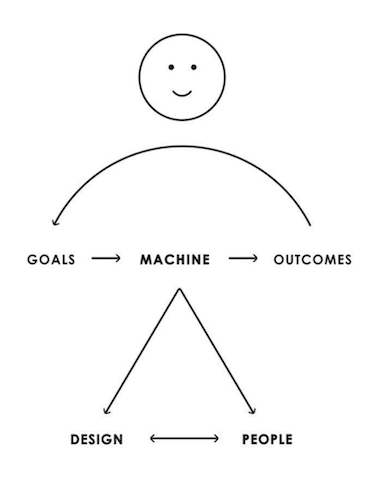
Let me explain.
As the leader of a team, you have your goals. The way you will try to achieve this goal is by building a machine. A machine is comprised of two components:
- The design (the things you have to get done)
- The people (who will do the things that needs to be done)
Constantly comparing the outcomes to your goals will allow you to discover whether you’re on the right track. This comparison allows you to tweak your “machine” – either by changing the design or the people.
Imagine you’re the head coach of a soccer team (for e.g Liverpool Football Club). Your goal is to win the English Premier League. You started the season with a 4-4-2 strategy (meaning four defenders, four midfielders and 2 strikers).

Note: This is a common strategy used in the game.
5 games into the season, and you realized you’ve lost all 5 games. Comparing your outcomes to your goal, you understand that if this losing streak continues, it’ll get more difficult for you to even get close to achieving your goal.
This also means it’s time to tweak your machine. Remember from the diagram that there are two main components you can affect – the design or the people.
You could possibly field the same players, but choose a different strategy (for e.g a 4-3-3). You could field the same strategy, but play different players in each position. Perhaps you found out that one of your defenders had a good striking instinct, and you decided to persuade him to take on a striking role instead.
The possibilities are limitless.

The Gist
As the leader of a team, your job is akin to that of a soccer coach. When the outcomes do not match with your goal, it is your job to tweak the machine. You could reorganize the team, hire new people, fire existing ones, or change up their job roles.
This is what Ray Dalio calls “evolving the machine”, and also why building the right team is a constant optimization process.
Just because your team has been organized a certain way, doesn’t mean it must stay that way forever.
And Buffer understands that.
The Reason Behind Buffer’s Change
Like most companies, Buffer’s marketing strategy was simple.
Explore a channel, validate it, then hire someone to run it.
They thought in terms of marketing channels. If content marketing worked, then they would hire a content marketer. If PR worked, they would hire a PR person.
For the most part, this approach is not wrong. After all, Buffer have had huge success following this model.
However, they knew they could do more. In fact, after running through some calculated simulations, Kevan Lee, Buffer’s Head of Marketing realized:

The Realization
Wow! Just a small 10% increase would reap a whole host of benefits to Buffer’s bottom line.
Not only that, whilst it was true the existing model worked, there were also frustrations. For example, it was extremely difficult to set proper goals. Some channels, like the blog weren’t merely a top-of-the-funnel strategy.
The blog encompassed the entire funnel – from awareness building to acquisition and even till retention and referrals.
“Our previous strategy was channel-based, which meant that someone will own the blog, someone will own social media and someone will own PR. What became tricky was when we realized that, for example, the blog owns the whole part of the funnel from reach to signup. It became very difficult to set goals and dedicate responsibilities.” Alfred said.

Another frustration was – while Buffer was a customer-focused company, building the strategy around marketing channels didn’t feel customer-focused. Customers don’t think about product discovery in terms of marketing channels; only marketers care about that.
Instead, a customer follows his/her own journey. And marketers, as Buffer felt, should align themselves to the customer journey.
Alfred said, “we are thinking of how to improve the customer journey, but if we’re thinking only about marketing channels, it might be hard to align the journey. So we went for an alternative approach to break it up into several parts.”
How Buffer Restructured Their Marketing Team
Like any good marketer, the team at Buffer knew making such a drastic change would only cause more harm than good. Furthermore, they only had an intuition that changing the structure would work, but there was no concrete evidence to suggest so.
Thus, it was important to test if this idea would work. While it may have sounded good in theory, it must be tested.
Running a small experiment also prevented the risk of completely overhauling systems that were already working, and preventing potential issues from arising due to such big changes.
As Alfred revealed to me, they first experimented with building out a separate squad while the marketing team continued its work on social media and the blog. The new marketing squad had one goal – see if they could affect a chosen metric meaningfully in six weeks.
The Experiment
Running this experiment over an entire quarter, the marketing squad (rotated amongst different members) tried to reduce churn for the first six weeks, and affect mobile acquisition for the next.
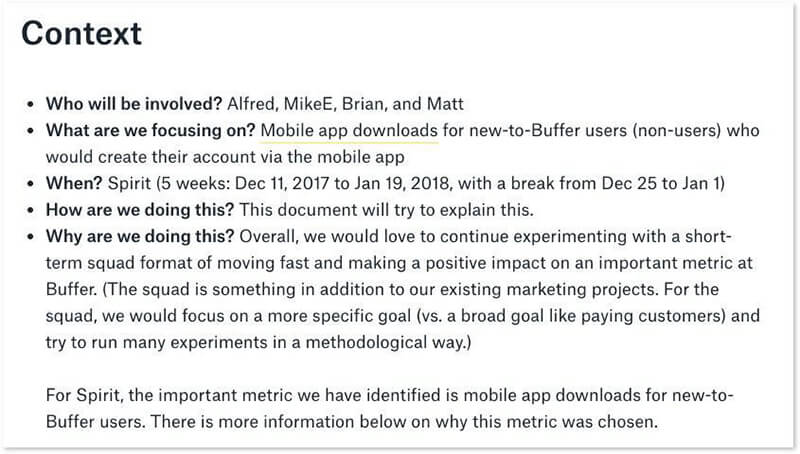
Only when they had decided that this model worked, did they implement it across the entire marketing team.
In the 2nd quarter of 2018, the Buffer marketing team was split into two squads: a brand squad and an acquire squad.
The brand squad focuses on reaching as many people in their target audience as possible (“awareness” in the pirate metrics model).
Their goal is reach, and their metric is visitors.
The acquire squad focuses on encouraging these people to sign up and try Buffer (“acquisition” in the pirate metrics model.) Their goal is signups and their metric is number of signups.
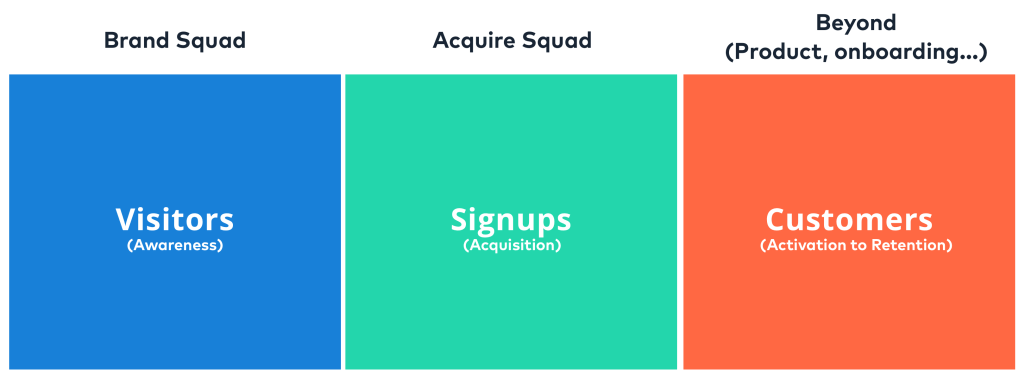
The rest of the funnel will be handled by the Product team.
It was interesting times. The Buffer marketing team had always focused on building the brand and generating awareness. This was the first time they would be exploring user acquisition.
That means an entirely new lens to view through and (hopefully) improve the Buffer ecosystem. This also meant that they would now be able to operate more effectively and capitalize on the potential opportunities Kevan had spotted.
Did It Work?
With such a big change in the structure of the marketing team, the question looms.
Has it worked out for them?
To be honest, it’s too early to say. Given that the change is relatively new, it will require some time before Buffer sees a huge impact on the numbers they’re tracking.
But Alfred thinks it is already an improvement.
“It’s a lot more on the softer side. Team collaboration is much better now. There’s a lot more collaboration within the team and it’s much easier to set our goals. For the acquisition squad, we know signup is our main goal, and we have metrics and constraints metrics to keep us honest. We’re not doing things just to get views. I definitely found the experience of working better, as well as the processes.”
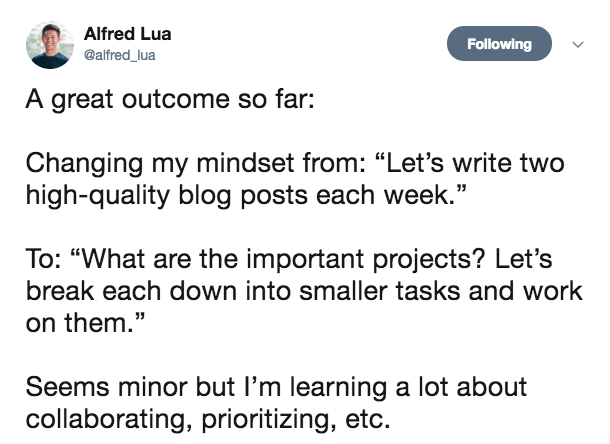
When we look over to the Brand squad, we see similar changes:
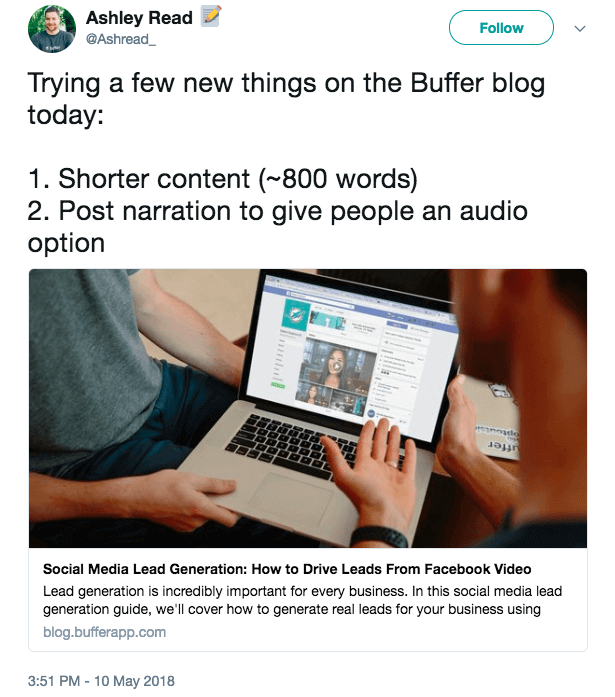
Ash, Alfred’s colleague has also been experimenting with entirely new ideas to see if he can push the brand squad ahead.
The best change so far is the fresh perspective to see and experiment with new things.
Alfred said, “on the business front, I feel that there are many areas we could optimize to improve the experience of a customer’s journey. For example, do we have sufficient information on our websites to help a visitor learn about Buffer? Do we have the right information on our pricing page to help someone decide if they should try Buffer? How can we make someone feel that it’ll be worth their time to take up a free trial?”
They’ve also begun to look at changes that were deprioritized in the past.
“For a long period of time at Buffer, our homepage was just a signup button. At the side was our slogan, and on the right was a sign up using Facebook, sign up using Twitter. There was no information about what Buffer is at all.”
“Only in the last few years did we start creating a proper homepage. Now we’re trying to expand on that a bit more. People are asking us a lot of questions like, what’s the difference between the plans? Ideas like can we create a landing page to answer that question? People ask, what features do you have? Then we ask, can we create a landing page that talks about all the different features?”
“A lot of it comes from understanding our customer’s journey and how we can improve that. I think of my role more of… Instead of getting people to sign up, how can I help people make the decision that Buffer is right for them? If Buffer is right for them, how can we make it easy for them to sign up?”
Build Around Your Customer Journey
The funny part is – Buffer is not alone.
Many startups at Buffer’s stage have realized the inefficiency of focusing on channels, and the power and advantage of focusing on building the marketing team around the customer journey.

Unbounce, a startup at a similar stage with Buffer had incidentally done the exact same thing.
“Before, we were structured conventionally by channels — content, social, partnerships, campaign strategy. We all had our own objectives and KPIs,” says Dan Levy, content director at Unbounce. Now, after “shuffling the deck,” the Unbounce marketing team is structured not around marketers’ work, but around the customer journey.
Their new strategy, based on what they call “agile principles” also saw them restructuring the marketing team, and building out marketing squads instead of focusing on channels. They have 4 squads (made up of designers, content creators and strategists):
- Awareness (KPI: Lead Generation)
- Evaluation (KPI: Sign up for 30-day trial)
- Adoption (KPI: Get customers to pay for product two times)
- Growth (KPI: Reduce churn and increase product adoption)
No matter which team you belong to, restructuring is a big change.
I don’t know if this strategy will work for you. But it seems like startups at Buffer and Unbounce’s size have all realized the same thing.
To evolve the team, you have to build around the customer journey.
Alfred says, “I think it could be a natural progression of how startups or teams are like. When there’s just one person doing marketing, that person does everything. But when you start hiring, you start hiring for channels instead of metrics. When you hire, you’re like “oh, I need a content person.” You don’t go, “oh, I need a reach person.” And then once you have a team of specialists in different channels, like our stage where we have nine people in a team, then you realize, “okay, is there a better way to organize the team?” Then you build on that.”
Final Thoughts
Buffer clearly knows what they are doing. They’ve done an unbelievable job getting to this point.
Personally, I feel there’s going to be a big challenge with this new direction…
They have two different teams focused on visitors and sign ups (and a third on the product).
But what if the brand squad is driving non-targeted traffic? Then the “Acquire” squad can’t do much from a conversion standpoint. So who is to blame?
By separating it in this way, you’d think it’s the Acquire squad (since they’re focused on conversion), but in actuality the Brand squad needs to make sure their traffic sources are still relevant.
It’s why I feel the entire marketing team needs to be focused on the end goal. In this case, “installs”. This is how everyone should be evaluated, with secondary goals for their own roles/departments.
I share this feedback just to help give you another perspective!